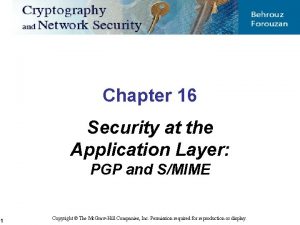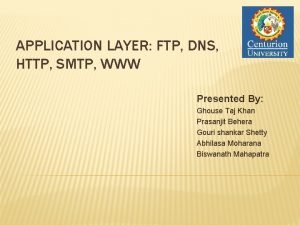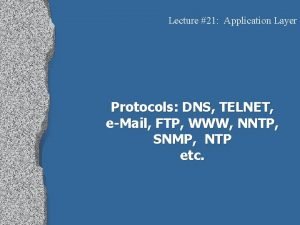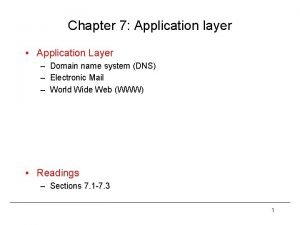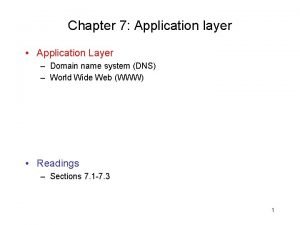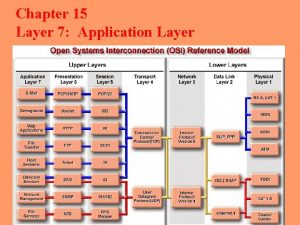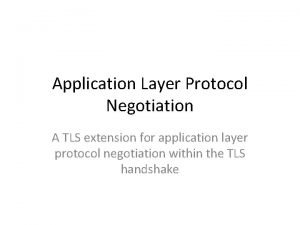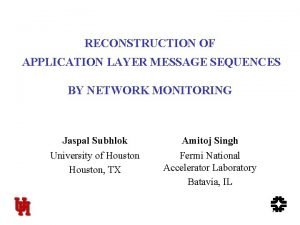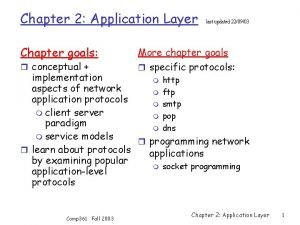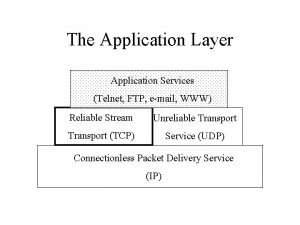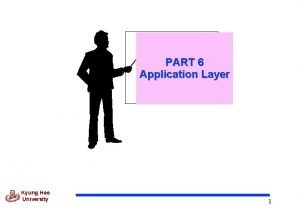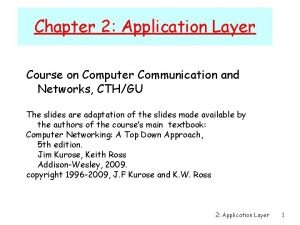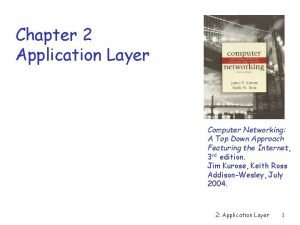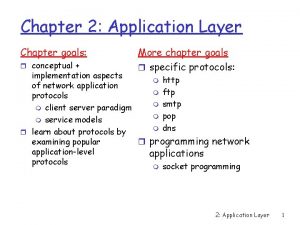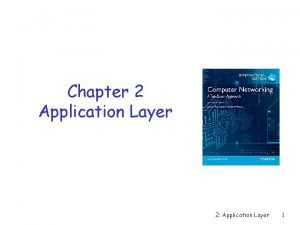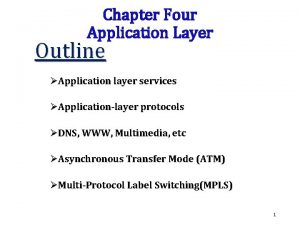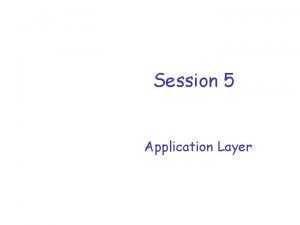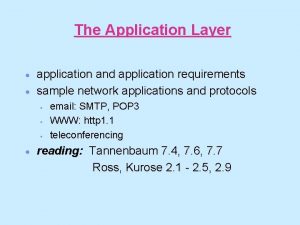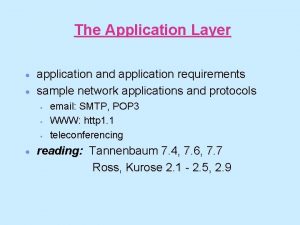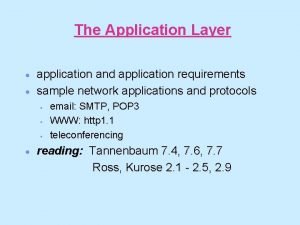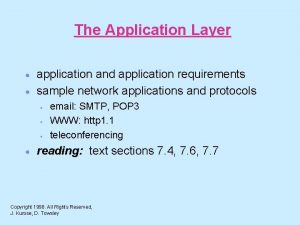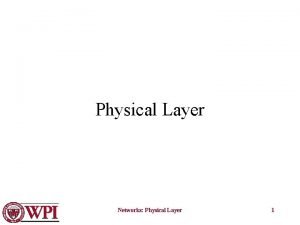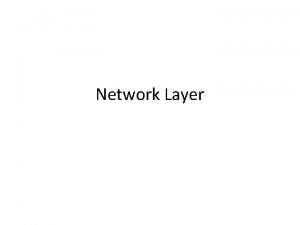Chapter 2 Application layer r 2 1 Principles








































- Slides: 40

Chapter 2: Application layer r 2. 1 Principles of network applications v v app architectures app requirements r 2. 2 Web and HTTP r 2. 4 Electronic Mail v SMTP, POP 3, IMAP r 2. 6 P 2 P applications r 2. 7 Socket programming with TCP r 2. 8 Socket programming with UDP r 2. 5 DNS 2: Application Layer 1

Pure P 2 P architecture r no always-on server r arbitrary end systems directly communicate peer-peer r peers are intermittently connected and change IP addresses r Three topics: v File distribution v Searching for information v Case Study: Skype 2: Application Layer 2

File Distribution: Server-Client vs P 2 P Question : How much time to distribute file from one server to N peers? us: server upload bandwidth Server us File, size F d. N u 1 d 1 u 2 ui: peer i upload bandwidth d 2 di: peer i download bandwidth Network (with abundant bandwidth) 2: Application Layer 3

File distribution time: server-client r server sequentially sends N copies: v NF/us time r client i takes F/di time to download Server F us d. N u 1 d 1 u 2 d 2 Network (with abundant bandwidth) Time to distribute F to N clients using = dcs = max { NF/us, F/min(di) } i client/server approach increases linearly in N (for large N) 2: Application Layer 4

File distribution time: P 2 P r server must send one Server F u 1 d 1 u 2 d 2 copy: F/us time us r client i takes F/di time Network (with d. N to download abundant bandwidth) u. N r NF bits must be downloaded (aggregate) r fastest possible upload rate: us + Sui d. P 2 P = max { F/us, F/min(di) , NF/(us + i S ui ) } 2: Application Layer 5

Server-client vs. P 2 P: example Client upload rate = u, F/u = 1 hour, us = 10 u, dmin ≥ us 2: Application Layer 6

File distribution: Bit. Torrent r P 2 P file distribution tracker: tracks peers participating in torrent: group of peers exchanging chunks of a file obtain list of peers trading chunks peer 2: Application Layer 7

Bit. Torrent (1) r file divided into 256 KB chunks. r peer joining torrent: has no chunks, but will accumulate them over time v registers with tracker to get list of peers, connects to subset of peers (“neighbors”) r while downloading, peer uploads chunks to other peers may come and go r once peer has entire file, it may (selfishly) leave or (altruistically) remain v 2: Application Layer 8

Bit. Torrent (2) Sending Chunks: tit-for-tat r Alice sends chunks to four Pulling Chunks neighbors currently r at any given time, sending her chunks at the different peers have highest rate different subsets of v re-evaluate top 4 every file chunks 10 secs r periodically, a peer r every 30 secs: randomly (Alice) asks each select another peer, neighbor for list of starts sending chunks that they have. v newly chosen peer may r Alice sends requests for join top 4 her missing chunks v “optimistically unchoke” v rarest first 2: Application Layer 9

Bit. Torrent: Tit-for-tat (1) Alice “optimistically unchokes” Bob (2) Alice becomes one of Bob’s top-four providers; Bob reciprocates (3) Bob becomes one of Alice’s top-four providers With higher upload rate, can find better trading partners & get file faster! 2: Application Layer 10

P 2 P: searching for information Index in P 2 P system: maps information to peer location (location = IP address & port number). Instant messaging File sharing (eg e-mule) r Index maps user names r Index dynamically to locations. tracks the locations of files that peers share. r When user starts IM application, it needs to r Peers need to tell inform index of its index what they have. location r Peers search index to determine where files determine IP address can be found of user. 2: Application Layer 11

P 2 P: centralized index original “Napster” design 1) when peer connects, it informs central server: v v Bob centralized directory server 1 peers IP address content 2) Alice queries for “Hey Jude” 3) Alice requests file from Bob 1 3 1 2 1 Alice 2: Application Layer 12

P 2 P: problems with centralized directory r single point of failure r performance bottleneck r copyright infringement: “target” of lawsuit is obvious file transfer is decentralized, but locating content is highly centralized 2: Application Layer 13

Query flooding r fully distributed v no central server r used by Gnutella r Each peer indexes the files it makes available for sharing (and no other files) overlay network: graph r edge between peer X and Y if there’s a TCP connection r all active peers and edges form overlay net r edge: virtual (not physical) link r given peer typically connected with < 10 overlay neighbors 2: Application Layer 14

Query flooding r Query message sent over existing TCP connections r peers forward Query message ry e r Query. Hit it Qu H ry sent over e Qu reverse Query path File transfer: HTTP Query. Hit Qu ery Query. Hit Scalability: limited scope flooding Qu er y 2: Application Layer 15

Gnutella: Peer joining peer Alice must find another peer in Gnutella network: use list of candidate peers 2. Alice sequentially attempts TCP connections with candidate peers until connection setup with Bob 3. Flooding: Alice sends Ping message to Bob; Bob forwards Ping message to his overlay neighbors (who then forward to their neighbors…. ) r peers receiving Ping message respond to Alice with Pong message 4. Alice receives many Pong messages, and can then setup additional TCP connections Peer leaving: see homework problem! 1. 2: Application Layer 16

Hierarchical Overlay r between centralized index, query flooding approaches r each peer is either a super node or assigned to a super node v v TCP connection between peer and its super node. TCP connections between some pairs of super nodes. r Super node tracks content in its children 2: Application Layer 17

P 2 P Case study: Skype clients (SC) r inherently P 2 P: pairs of users communicate. r proprietary application Skype login server -layer protocol (inferred via reverse engineering) r hierarchical overlay with SNs r Index maps usernames to IP addresses; distributed over SNs Supernode (SN) 2: Application Layer 18

Peers as relays r Problem when both Alice and Bob are behind “NATs”. v NAT prevents an outside peer from initiating a call to insider peer r Solution: v Using Alice’s and Bob’s SNs, Relay is chosen v Each peer initiates session with relay. v Peers can now communicate through NATs via relay 2: Application Layer 19

Chapter 2: Application layer r 2. 1 Principles of network applications r 2. 2 Web and HTTP r 2. 3 FTP r 2. 4 Electronic Mail v r 2. 6 P 2 P applications r 2. 7 Socket programming with TCP r 2. 8 Socket programming with UDP SMTP, POP 3, IMAP r 2. 5 DNS 2: Application Layer 20

Socket programming Goal: learn how to build client/server application that communicate using sockets Socket API r introduced in BSD 4. 1 UNIX, 1981 r explicitly created, used, released by apps r client/server paradigm r two types of transport service via socket API: v unreliable datagram v reliable, byte streamoriented socket a host-local, application-created, OS-controlled interface (a “door”) into which application process can both send and receive messages to/from another application process 2: Application Layer 21

Socket-programming using TCP Socket: a door between application process and endend-transport protocol (UCP or TCP) TCP service: reliable transfer of bytes from one process to another controlled by application developer controlled by operating system process socket TCP with buffers, variables host or server internet socket TCP with buffers, variables controlled by application developer controlled by operating system host or server 2: Application Layer 22

Socket programming with TCP Client must contact server r server process must first be running r server must have created socket (door) that welcomes client’s contact Client contacts server by: r creating client-local TCP socket r specifying IP address, port number of server process r When client creates socket: client TCP establishes connection to server TCP r When contacted by client, server TCP creates new socket for server process to communicate with client v allows server to talk with multiple clients v source port numbers used to distinguish clients (more in Chap 3) application viewpoint TCP provides reliable, in-order transfer of bytes (“pipe”) between client and server 2: Application Layer 23

Client/server socket interaction: TCP Server Client (running on hostid) create socket, port=x, for incoming request: welcome. Socket = Server. Socket() TCP wait for incoming connection request connection. Socket = welcome. Socket. accept() read request from connection. Socket write reply to connection. Socket close connection. Socket setup create socket, connect to hostid, port=x client. Socket = Socket() send request using client. Socket read reply from client. Socket close client. Socket 2: Application Layer 24

Stream jargon r A stream is a sequence of characters that flow into or out of a process. r An input stream is attached to some input source for the process, e. g. , keyboard or socket. r An output stream is attached to an output source, e. g. , monitor or socket. Client process client TCP socket 2: Application Layer 25

Socket programming with TCP Example client-server app: 1) client reads line from standard input (in. From. User stream) , sends to server via socket (out. To. Server stream) 2) server reads line from socket 3) server converts line to uppercase, sends back to client 4) client reads, prints modified line from socket (in. From. Server stream) 2: Application Layer 26

Example: Java client (TCP) import java. io. *; import java. net. *; class TCPClient { public static void main(String argv[]) throws Exception { String sentence; String modified. Sentence; Create input stream Create client socket, connect to server Create output stream attached to socket Buffered. Reader in. From. User = new Buffered. Reader(new Input. Stream. Reader(System. in)); Socket client. Socket = new Socket("hostname", 6789); Data. Output. Stream out. To. Server = new Data. Output. Stream(client. Socket. get. Output. Stream()); 2: Application Layer 27

Example: Java client (TCP), cont. Create input stream attached to socket Buffered. Reader in. From. Server = new Buffered. Reader(new Input. Stream. Reader(client. Socket. get. Input. Stream())); sentence = in. From. User. read. Line(); Send line to server out. To. Server. write. Bytes(sentence + 'n'); Read line from server modified. Sentence = in. From. Server. read. Line(); System. out. println("FROM SERVER: " + modified. Sentence); client. Socket. close(); } } 2: Application Layer 28

Example: Java server (TCP) import java. io. *; import java. net. *; class TCPServer { Create welcoming socket at port 6789 Wait, on welcoming socket for contact by client Create input stream, attached to socket public static void main(String argv[]) throws Exception { String client. Sentence; String capitalized. Sentence; Server. Socket welcome. Socket = new Server. Socket(6789); while(true) { Socket connection. Socket = welcome. Socket. accept(); Buffered. Reader in. From. Client = new Buffered. Reader(new Input. Stream. Reader(connection. Socket. get. Input. Stream())); 2: Application Layer 29

Example: Java server (TCP), cont Create output stream, attached to socket Data. Output. Stream out. To. Client = new Data. Output. Stream(connection. Socket. get. Output. Stream()); Read in line from socket client. Sentence = in. From. Client. read. Line(); capitalized. Sentence = client. Sentence. to. Upper. Case() + 'n'; Write out line to socket out. To. Client. write. Bytes(capitalized. Sentence); } } } End of while loop, loop back and wait for another client connection 2: Application Layer 30

Chapter 2: Application layer r 2. 1 Principles of network applications r 2. 2 Web and HTTP r 2. 3 FTP r 2. 4 Electronic Mail v r 2. 6 P 2 P applications r 2. 7 Socket programming with TCP r 2. 8 Socket programming with UDP SMTP, POP 3, IMAP r 2. 5 DNS 2: Application Layer 31

Socket programming with UDP: no “connection” between client and server r no handshaking r sender explicitly attaches IP address and port of destination to each packet r server must extract IP address, port of sender from received packet application viewpoint UDP provides unreliable transfer of groups of bytes (“datagrams”) between client and server UDP: transmitted data may be received out of order, or lost 2: Application Layer 32

Client/server socket interaction: UDP Server (running on hostid) create socket, port= x. server. Socket = Datagram. Socket() read datagram from server. Socket write reply to server. Socket specifying client address, port number Client create socket, client. Socket = Datagram. Socket() Create datagram with server IP and port=x; send datagram via client. Socket read datagram from client. Socket close client. Socket 2: Application Layer 33

Example: Java client (UDP) Client process Input: receives packet (recall that. TCP received “byte stream”) Output: sends packet (recall that TCP sent “byte stream”) client UDP socket 2: Application Layer 34

Example: Java client (UDP) import java. io. *; import java. net. *; Create input stream Create client socket Translate hostname to IP address using DNS class UDPClient { public static void main(String args[]) throws Exception { Buffered. Reader in. From. User = new Buffered. Reader(new Input. Stream. Reader(System. in)); Datagram. Socket client. Socket = new Datagram. Socket(); Inet. Address IPAddress = Inet. Address. get. By. Name("hostname"); byte[] send. Data = new byte[1024]; byte[] receive. Data = new byte[1024]; String sentence = in. From. User. read. Line(); send. Data = sentence. get. Bytes(); 2: Application Layer 35

Example: Java client (UDP), cont. Create datagram with data-to-send, length, IP addr, port Send datagram to server Datagram. Packet send. Packet = new Datagram. Packet(send. Data, send. Data. length, IPAddress, 9876); client. Socket. send(send. Packet); Datagram. Packet receive. Packet = new Datagram. Packet(receive. Data, receive. Data. length); Read datagram from server client. Socket. receive(receive. Packet); String modified. Sentence = new String(receive. Packet. get. Data()); System. out. println("FROM SERVER: " + modified. Sentence); client. Socket. close(); } } 2: Application Layer 36

Example: Java server (UDP) import java. io. *; import java. net. *; Create datagram socket at port 9876 class UDPServer { public static void main(String args[]) throws Exception { Datagram. Socket server. Socket = new Datagram. Socket(9876); byte[] receive. Data = new byte[1024]; byte[] send. Data = new byte[1024]; while(true) { Create space for received datagram Receive datagram Datagram. Packet receive. Packet = new Datagram. Packet(receive. Data, receive. Data. length); server. Socket. receive(receive. Packet); 2: Application Layer 37

Example: Java server (UDP), cont String sentence = new String(receive. Packet. get. Data()); Get IP addr port #, of sender Inet. Address IPAddress = receive. Packet. get. Address(); int port = receive. Packet. get. Port(); String capitalized. Sentence = sentence. to. Upper. Case(); send. Data = capitalized. Sentence. get. Bytes(); Create datagram to send to client Write out datagram to socket } Datagram. Packet send. Packet = new Datagram. Packet(send. Data, send. Data. length, IPAddress, port); server. Socket. send(send. Packet); } } End of while loop, loop back and wait for another datagram 2: Application Layer 38

Chapter 2: Summary our study of network apps now complete! r application architectures v client-server v P 2 P v hybrid r application service requirements: v reliability, bandwidth, delay r specific protocols: v HTTP v FTP v SMTP, POP, IMAP v DNS v P 2 P: Bit. Torrent, Skype r socket programming r Internet transport service model v v connection-oriented, reliable: TCP unreliable, datagrams: UDP 2: Application Layer 39

Chapter 2: Summary Most importantly: learned about protocols r typical request/reply message exchange: v v client requests info or service server responds with data, status code r message formats: v headers: fields giving info about data v data: info being communicated Important themes: r control vs. data msgs v in-band, out-of-band r centralized vs. decentralized r stateless vs. stateful r reliable vs. unreliable msg transfer r “complexity at network edge” 2: Application Layer 40
 Fig 19
Fig 19 Brush border enzymes
Brush border enzymes Secure socket layer and transport layer security
Secure socket layer and transport layer security Layer 6 presentation layer
Layer 6 presentation layer Secure socket layer and transport layer security
Secure socket layer and transport layer security Secure socket layer and transport layer security
Secure socket layer and transport layer security Secure socket layer and transport layer security
Secure socket layer and transport layer security Layer 2 e layer 3
Layer 2 e layer 3 Layer-by-layer assembly
Layer-by-layer assembly Layer 2 vs layer 3 bitstream
Layer 2 vs layer 3 bitstream Pgp packet structure
Pgp packet structure Smtp application layer
Smtp application layer Snmp
Snmp Domain name system in application layer
Domain name system in application layer Domain name system in application layer
Domain name system in application layer Layer 7 application
Layer 7 application Application-layer protocol negotiation
Application-layer protocol negotiation Application layer message
Application layer message Introduction to application layer
Introduction to application layer Application layer protocols
Application layer protocols Application layer protocols
Application layer protocols Application layer
Application layer Telnet
Telnet Application layer
Application layer Application layer
Application layer Application layer protocols
Application layer protocols Application layer protocols
Application layer protocols Application layer protocols
Application layer protocols Application layer protocols
Application layer protocols Principles of reliable data transfer in transport layer
Principles of reliable data transfer in transport layer Ultrasonic inspection machine
Ultrasonic inspection machine Slab vs cast
Slab vs cast Chapter 3 transport layer
Chapter 3 transport layer 18:2 writing a cover letter and preparing a resume
18:2 writing a cover letter and preparing a resume Chapter 17:1 developing job keeping skills
Chapter 17:1 developing job keeping skills Application software
Application software Chapter 5 elasticity and its application multiple choice
Chapter 5 elasticity and its application multiple choice Chapter 9 application: international trade answers
Chapter 9 application: international trade answers Chapter 30 principles of pharmacology
Chapter 30 principles of pharmacology Principles of marketing chapter 7
Principles of marketing chapter 7 Principles of marketing chapter 5
Principles of marketing chapter 5










